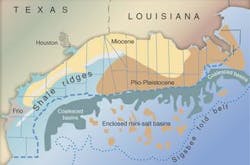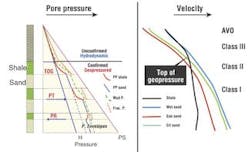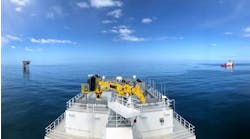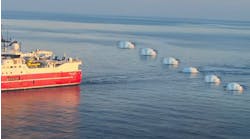Exploration potentials include structural plays, seismic anomalies
Selim Shaker
Geopressure Analysis Services
The offshore northern Gulf of Mexico (shelf and deepwater) has immense potential of oil and gas reserves if all exploration tools can be integrated effectively. Stratigraphic and structural settings are the foundation of generating a prospect.
The quest for global energy in offshore waters began and developed in the Gulf of Mexico. This so-called mature basin in North America is unique in that reactivated development of potential domestic reserves has occurred several times from the 1950s until now. Exploration was spurred by adding the sub-salt plays to the conventional prospect's inventory in the 1980s and recently drilling in deepwater reached a record-breaking level. If all exploration tools are used, the untapped reserves of Gulf of Mexico oil and gas will supply the energy needs of future generations.
In the search for oil and gas fields, the importance of evaluating sealing effectiveness was not realized until the late 1990s. This discipline came into play when adequate structural closure associated with indicative hydrocarbon seismic attributes failed to find commercial hydrocarbon in many exploration endeavors.
The latest advances in geophysical technique and the power of computer modeling facilitate better interpretation of the structural geology and the seismic attributes related to lithology. However, we have largely neglected the fluids that fill the pore spaces in the rocks. We have searched diligently for the minority fluids (oil and gas), but we have not studied the majority of host fluids (water). In particular, we have not studied the energy held by these subsurface fluids.
Compartmentalization, as a result of changing the geopressure gradient in the subsurface fluids, is one of the most critical issues in evaluating prospective leads. The sealing effectiveness of shale caps and fault zones is vital to evaluate the capability of a subsurface compartment's ability to retain hydrocarbons.
null
null
Main geological basins
During the last 30 million years, the depositional feeder systems moved from west (South Texas) to east (the current Mississippi Delta) in intermittent fashion. This influx of sediment was controlled by the relative change of sea level and the accommodation rate of the down dip basin in receiving these deposits.
The upper Oligocene Frio-Vicksburg major sediment's avenues were between South Padre and Mustang Islands. Consequently, the early and middle Miocene sediments dominated the Texas offshore and most of the western tier of Louisiana's offshore. This system was laid down in a strike (NE-SW) orientation and dominated by regional faults and shale ridges with intra-basin sand and shale sequences (Mustang to West Cameron areas). Due east from the Camerons, the Middle-Late Miocene large deltaic fans spread from the shelf to the northern fringes of the deepwater basin. The loading of these immense sediments created a variety of structures sometimes rooted by Louann salt.
During the Plio-Pleistocene, when the sea level dropped substantially, the sediment influx reached out to the deep basin for a long distance down-dip. This epoch lead to a vast salt withdrawal into the deepest part of the basin. Now, most of the allochthonous (mobile) salt occupies the deepwater (>600 ft) creating new exploration plays. The interaction between the salt and relatively young sediments taking place in the deepwater basin is one of the most complex settings facing offshore Texas/Louisiana exploration.
Within the salt basins several play concepts range from:
- Coalesced mini-basins where the salt has withdrawn almost completely
- Enclosed mini-basins where salt still represents the foundation of the basin
- The distal fold belt along the Sigsbee Escarpment where salt, still moving on the seabed, causes compressional structural traps.
Structural plays
The specific density contrast between the hydrocarbons (minority fluids) and the formation water (host fluid) is the fundamental reason that wildcats tap the apex portion of a structural play. This was the initial and is still the main drilling target when gravity, magnetic, and an earlier phase of seismic were used as exploration tools. In some cases, the negative side of drilling the apex portion of a prospect is the lack of well developed reservoir facies and the relatively high formation pressure, which leads to a lot of drilling and entrapment problems.
In offshore Texas and the Camerons, the structurally high shale ridges (Brazos and Corsair) are the least successful exploration plays. On the other hand, the intra-basin plays were and still are more promising. The crestal, top-of-the-salt domes in offshore Louisiana represent the least attractive exploration targets relative to the flanks and the rim basins. The advance in seismic acquisitions, processing, and interpretation of attributes from the 1980s until now spurred the idea of finding more promising objectives off the crest of a prospective structure.
The left panel shows a generic pore pressure profile. The right panel shows the changes in shale and different sand reservoirs velocities in relation to the top of geopressure.
Seismic anomalies
The reflectivity of seismic wave in the subsurface depends on the changes of lithology and fluid content at the different bedding planes. The larger the contrast (acoustic impedance), the stronger the amplitude we can see. This strong amplitude is referred to as seismic anomalies and bright spots. New technologies in acquisition and processing led to a new tool of seismic exploration related to amplitude variation with offset (AVO) in gas reservoirs.
In spite of these advancements of integrating the structural setting with the AVO analysis, we are still far from substantially reducing risk when drilling a potentially feasible economic prospect. This is because many elements in the subsurface can contribute to, alter, and obscure seismic attributes. Lateral and vertical facies changes and the presence of fizz gas are usually associated with amplitude anomalies. Moreover, AVO classification (Class I, II, and III) is impacted by the age of the sediments and velocity difference between the shale (seal) and sand (reservoir), fluid content and more importantly, geopressure settings.
Studies show that seismic velocities in the shale and sand behave differently in the upper hydrostatic section (Class III) than in the geopressured section below (Class I). On the contrary, around the interface between the above-mentioned two zones (top of geopressure), velocities in the seal and reservoir are in proximity (Class II). This sheds light on the importance of defining the depth to the top of geopressure before processing with any AVO analysis.
Geopressure compartmentalization
The subsurface formation pore pressure (PP) profile is usually divided into two main segments: the upper, normally pressured (unconfined and hydro-dynamically active) and the abnormally geopressured (confined) section below. The interface between the two systems is usually associated with an increase in the pore pressure gradient (PG). Consequently, the depth to the top of geopressure (TOG) represents the pivot point at which hydrocarbon entrapment becomes substantially impacted by the change in pressure gradients throughout the geopressured system.
The development of the geopressured compartmentalization setting is mainly driven by lithology, structure, principle and minimum stresses, and reservoir fluids type. Pressure gradient increases exponentially in the seals and follows the linear regional hydrostatic gradient in the reservoirs. Subject to fluid or gas density, the presence of hydrocarbon in the reservoir reduces the slope on this linear gradient.
Deposition of additional sediments in a structurally relaxed (extensional) basin leads to an increase of the principal stress and consequently results in a higher transgressive PP profile. This transgressive pressure (PT) profile is usually represented by a cascade fashion profile, as long as the basin subsidence accommodates the volume of sediment input with the absence of structural failure.
Conversely, in the case of structural failure and/or when PP reaches the limit of the fracture pressure (FP), pressure regression (PR) takes place. This common regression phenomenon is usually a result of the presence of communication paths (structural failure) through faults and salt interfaces and/or hydraulic fracturing between the deep, highly pressured reservoir and the shallower, lesser-pressured reservoir.
The size and direction of the pressure envelope's shift across the interface, from the seal (shale) to the reservoir (sand), are responsible for shaping the PP and FP profile with depth. In case of a large progressive shift, a prolific economic hydrocarbon-bearing reservoir is encountered. In case of pressure regression due to structural failure and/or hydraulic fracturing, PP in the reservoir drops to a lower PP envelope. This leads to a seal failure and consequently a breached reservoir.
Exploration tips for geopressure
In the hydrostatic shallow section:
- Four-way closures have high success rate
- Faulted three-way closures are marginal, and hydrocarbon (HC) is subject to percolate to the sea floor forming gas chimneys, especially in deepwater younger sediments, and causes shallow hazards
- Seismic anomalies and AVO (Class III) are most likely to succeed if reservoir modeling has been done properly.
Around the top of the geopressure zone:
- The most profitable and least expensive to drill
- Four-way closure and three-way faulted closures are successful
- The thickness of the HC column in the three-way closure relies on fault sealing/cap seal capacities
- AVO (Class II) is ambiguous due to velocity perturbations in this short interval.
- Large reserves are associated with good pressure drive and long lifespan fields
- Sealing capacity (shift in pressure envel-opes) and retention capacity (difference between pore and fracture pressures) are essential values for calculating risk assessments
- Geopressure compartmentalization in deepwater salt basins is complex due to confusion of the principle stresses orientations by salt bodies
- Drop in the subsurface pressure (regression) indicates ineffective seal (top cap and/or fault) and consequently a breached reservoir
- AVO analysis (Class I) is relatively intricate due to HC infusion in the cap rock from the reservoir below.
In the geopressured zones:
In summary, the offshore northern Gulf of Mexico (shelf and deepwater) has immense potential of oil and gas reserves if all exploration tools can be integrated effectively. Stratigraphic and structural settings are the foundation of generating a prospect. Seismic attribute interpretation comes into play as the possible indication of hydrocarbon presence. The change in petrophysical properties (velocity and density) due to the presence of gas in reservoirs led to the wide spread of using AVO as an exploration tool.
Due to the close density between oil and water, seismic amplitude in oil zones is subtle. Optimum stratigraphic, structural, and seismic anomalies do not necessarily assure certain success. Integrating the geopressure compartmentalization setting can reduce the risk to a large extent. Therefore, compartmentalization assessment needs to be integrated into the process of evaluating a prospect prior to drilling.
For more information, contact Selim Shaker at 281-759-7189 or email: [email protected].






